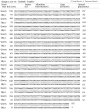Frequency of PER, VEB, SHV, TEM and CTX-M Genes in Resistant Strains of Pseudomonas aeruginosa Producing Extended Spectrum β-Lactamases
- PMID: 25789123
- PMCID: PMC4350043
- DOI: 10.5812/jjm.13783
Frequency of PER, VEB, SHV, TEM and CTX-M Genes in Resistant Strains of Pseudomonas aeruginosa Producing Extended Spectrum β-Lactamases
Abstract
Background: Pseudomonas aeruginosa is the most common pathogen causing nosocomial infections. Resistance of P. aeruginosa strains to broad-spectrum cephalosporins may be mediated by extended-spectrum β-lactamases (ESBLs).
Objectives: We intended to investigate the prevalence of ESBLs and antimicrobial susceptibilities of P. aeruginosa isolated from patients in Zahedan, Iran.
Materials and methods: In this cross-sectional study, during 2012-2013, 116 P. aeruginosa isolates were collected from a teaching hospital in Zahedan, Iran. Susceptibility to eight antimicrobial agents was carried out by disk diffusion method. The ESBL producing strains were detected by combination disk test (CDT). ESBL positive isolates as well as other isolates showing minimum inhibitory concentrations (MICs) ≥ 4 μg/mL for ceftazidime, cefotaxime, ceftriaxone and aztreonam, were screened for the presence of the genes encoding blaTEM, blaSHV, blaPER-1 and blaVEB-1, by polymerase chain reaction (PCR).
Results: Ciprofloxacin and piperacillin were the most efficient antipseudomonal agents. The results disclosed that 19 (16.37%) of the isolates were multidrug resistant and 8 (6.89%) were ESBL-positive. Of the 116 isolates, 30 (25.86%) were resistant to at least one of the antibiotics ceftazidime, ceftriaxone, cefotaxime or aztreonam and among these 30 (100%), 4 (13.3%), 2 (6.6%) and 2 (6.6%), amplified blaTEM, blaVEB-1, blaPER-1 and blaSHV, respectively. From the 30 TEM-positive isolates, 22 were ESBL-negative. Sequencing of the ESBL genes verified the accuracy of the PCR products.
Conclusions: According to our results, blaTEM-116 was the most frequent isolated ESBL gene among the P. aeruginosa strains isolated from patients.
Keywords: Extended-Spectrum beta-Lactamase; Pseudomonas aeruginosa.
Figures
References
-
- Shacheraghi F, Shakibaie MR, Noveiri H. Molecular Identification of ESBL genes blaGES-1, blaVEB-1, blaCTX-M blaOXA-1, blaOXA-4, blaOXA-10 and blaPER-1 in Pseudomonas aeruginosa strains isolated from burn patients by PCR, RFLP and sequencing techniques. Int J Biol life Sci. 2010;3(6):138–42.
-
- Paterson DL. Extended-spectrum beta-lactamases: the European experience. Curr Opin Infect Dis. 2001;14(6):697–701. - PubMed
LinkOut - more resources
Full Text Sources
Other Literature Sources

